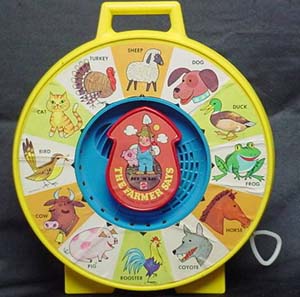Back in the 1960’s, the new tech gadget that fascinated young children was the See ‘n Say, a toy developed and sold by Mattel. Many adults of my generation will fondly remember playing with a See ‘n Say — pointing the arrow, pulling the string, and hearing the “quack,” “moo” or “oink” of the selected farm animal.
I can remember playing with a particularly old and well loved See ‘n Say that was starting to wear out. The rotating mechanism inside the toy turned too slowly and when I pulled the string, the animal sounds came out low and distorted. My friends and I laughed with surprise when we heard the low, weak “Mooooooooo” of the cow. We thought these slow, weird animal noises were hilarious!
Today, children can play See ‘n Say using an app on their iPads or iPhones. I think it’s a shame, though, that children using digital games don’t have the same experience that I did when a toy breaks or malfunctions. When my See ‘n Say began to wear out, the distorted noises I heard were an important clue to what was happening inside the toy. It reminded me of my record player and what happened to the music when the speed of the turntable was too slow. I was able to conclude that something inside the toy was turning too slowly. By playing with a broken toy, I was able to draw conclusions about the engineering and design involved in producing the toy’s audio.
In my new book, Creating a Beautiful Mess, I quote David Elkind, the author of The Power of Play because I share his concern that children need experiences with all kinds of toys and machines, not just electronic games and toys. Elkind writes, “The complexity of electronic technology changes the child’s intellectual engagement with these toys. The mechanics of soapbox cars and windup toys are easy for children to understand. Toys with embedded microcontrollers, in contrast, work as if by magic…. It is at least possible that children’s inability to figure out how their playthings work can dampen their scientific curiosity.”
This summer, in my work for the Center for Talent Development, I’ve observed our young students learning science, technology and engineering concepts by taking things apart and putting them back together again. For example, in our “Hexbug Habitats” course, children as young as six take apart Hexbug toys and analyze the mechanical engineering, such as motors and sensors, inside these little robots. In a course called “How Things Work,” older students take apart small appliances, televisions, cell phones and computers. These experiences may not be as hilarious as the broken oinks and moos that I heard from my old See ‘n Say, but the children are gaining a depth of knowledge that can’t be learned by simply playing with an app on a screen.
Photo credit: The Talking Toy Hall of Fame


Recent Comments